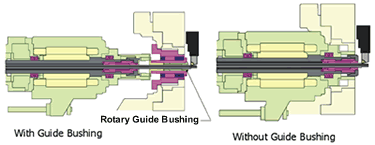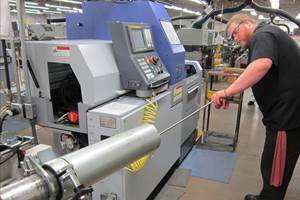Swiss Democracy
Many builders of Swiss-type moving headstock machines have introduced models that do not require the use of a guide bushing to support the workpiece.
The defining piece of technology in a traditional Swiss-type lathe is the use of a guide bushing that serves as a support for cutting long, slender parts without deflection. It has always been designed to solve the problem of accurately turning parts when length-to-diameter ratios couldn’t be practically machined any other way.
As CNC Swiss technology has evolved in its capability, more shops are using these machines for a wider array of applications. With subspindles, live tooling and various attachments, the Swiss-type machine is attractive to shops trying to improve throughput by producing complete parts in a single handling.
However, in many cases, parts being produced on a Swiss machine are not really “Swiss-type” parts—specifically, parts with a length-to-diameter ratio below 3-to-1. It is estimated that 50 to 60 percent or more of parts being made on Swiss machines do not require the defining guide bushing.
As a response to this unnecessary component, many builders of Swiss-type moving headstock machines have introduced models that do not require the use of a guide bushing to support the workpiece. Rather, a headstock-mounted collet has sufficient stroke to extend into the cutting zone.
Taking this idea further, Tsugami (East Granby, Connecticut) offers several models of Swiss-types with an interchangeable housing that allows a shop to run its machine with or without a guide bushing, as it best fits the application. A detachable housing carries a driven guide bushing and operates as a traditional Swiss-type. For non-Swiss parts, the guide bushing housing can be removed and replaced with a cover (to keep chips and coolant out of the headstock). The spindle nose and collet have sufficient stroke to extend into the cutting zone. The change-over from guide bushing to bushless takes about 10 minutes.
According to Dan Murphy, regional manager for Rem Sales, there are inherent process advantages to eliminating the guide bushing, if possible. On a guide bushing machine, the fit between the barstock and the bushing is snug. To accommodate variance from bar to bar in order to maintain a consistent tolerance between the bar and bushing, shops must prepare the bar before use. Often it requires that the barstock be centerless ground to size for best results.
Because the collet used on a bushless machine is more forgiving of size variation in barstock, cold-drawn bar can be used without the need for pre-process preparation. Another savings, especially relevant with current material prices, is a much shorter remnant created using a bushless machine. The collet is mounted on the sliding headstock nose, eliminating the distance between the collet and guide bushing and reducing a typical remnant of 5 or 6 inches to 2 inches. Savings such as this are significant.
Without the guide bushing, non-round bar and chucked parts can be run without difficulty. Hex and extruded stock can be fed through a bar feeder while chucked parts, blanks, forgings and castings can be loaded/unloaded with a gantry robot or other feeder device. The ability to run parts like these increases the flexibility of the already very productive Swiss-type into new application areas.
Eliminating the guide bushing omits a potential source of inaccuracy, Dan says. Using only the collet as a support for the part, rotational speeds can be run higher for better production rates and surface finishes. Moreover, holding roundness is much easier without the guide bushing because the dimension is directly tied to the spindle’s accuracy.
In operation, the bushless machine offers no compromise in the ability to machine complex workpieces. The tooling scheme is identical for either type of machine as is use of subspindles and backworking tools.
One machining advantage that the bushless design brings to turning is multiple passes. On a guide-bushed machine, if the area of the part to be turned is longer than the “land area” of the guide bushing, one pass is all that can be programmed, the change in diameter will cause the part to fall out of the guide bushing. On a bushless setup, because the workpiece blank is gripped only in the collet, there is no restriction on the number of turning passes for roughing and finishing that can be taken up to the nose of the spindle.
Tsugami offers this bushed/bushless option on several machine models from 12-mm to 26-mm diameters. The flexibility it offers shops running a variety of Swiss and non-Swiss parts to tailor the machine to the application may be worth considering.
Related Content
6 Tips for Training on a Swiss-Type Lathe
There are nuances to training a person to effectively operate a Swiss-type lathe. A shop I visited a while back offers some suggestions.
Read MoreShop Optimizes its Swiss-Turning Flexibility
Paramount Machine uses various Swiss-type lathes, some with a B axis, to produce parts more effectively than it did on conventional chucker lathes. Today, nearly every job under 1.5 inches in diameter runs across those machines even if the batch size is a mere 5 pieces.
Read MoreStories of Swiss First Additions
A handful of shops share their stories about the how’s and why’s of adding their first Swiss-type CNC turning centers.
Read MoreShop Sets its Sights on Precise Tool Alignment
A Wisconsin shop has found that visual tool alignment technology has improved tool life and surface finishes for its Swiss-type lathes while increasing throughput as well.
Read MoreRead Next
A Tooling Workshop Worth a Visit
Marubeni Citizen-Cincom’s tooling and accessory workshop offers a chance to learn more about ancillary devices that can boost machining efficiency and capability.
Read MoreEmerging Leaders Nominations Now Open
Here’s your chance to highlight a young person in your manufacturing business who is on the path to be a future leader moving your company forward.
Read More









.jpg;maxWidth=300;quality=90)




.jpg;maxWidth=300;quality=90)







